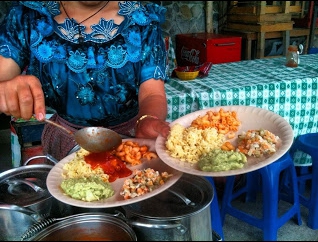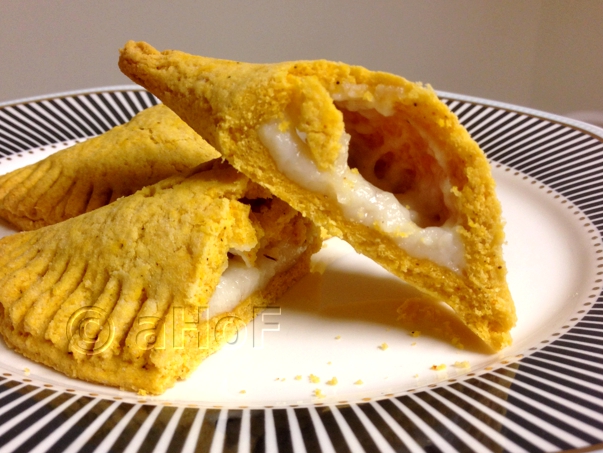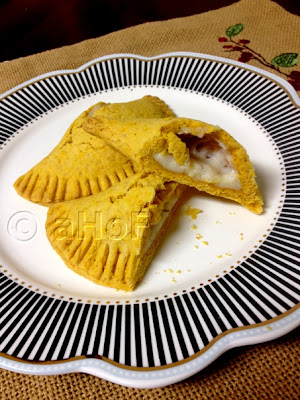 |
| Maya Woman selling lunch from doorstep |
 |
| Annatto Seeds, called Achiote in Spanish |
The first thing I realized is that it called for "harina de Salpor" as part of the dry ingredients. What the heck is THAT, I wondered? And if I don't know what that is, what in the world did I use when I made them before? Thus ensued an exhaustive search on the internet, only to find that apparently, while "harina de Salpor" is called for in more than one version of these empanadas, no one really appears to know what, exactly, it is. More than one site had someone speculating that it was a corn flour, but that it had more "fecula." Great! Another word I didn't know! I found that fecula translates to "starch". Could harina de salpor be cornstarch? I didn't think so, as cornstarch was called "maizena". Still, it seemed I was finally getting somewhere.
 |
| Guatemalan Empanadas de Manjar |
I used the combination of masa harina and cornstarch for my empanadas. I also combined butter and lard as the "manteca" component. Margarine could be used also, and any one of these things (butter, margarine, lard, shortening) could be used on their own. The amount of water needed for the dough will depend on how dry your climate. Start with 3/4 cup and add more to bind, if needed. My method of mixing the dough may not be "typical", but it works just fine. ;-)
 |
| Guatemalan Empanadas de Manjar |
Empanadas de Manjar
Makes 26 to 30 empanadas
CORNSTARCH FILLING / MANJAR:
2 cups milk
1 (3-inch) stick true (soft-stick) cinnamon
3 tablespoons (1 ounce / 30 g.) cornstarch
½ cup (3.8 ounces / 108 g.) granulated sugar
½ teaspoon vanilla extract
EMPANADA DOUGH:
1 pound (3 1/2 cups / 453 g.) all-purpose flour
¼ pound (scant 1 cup / 112 g.) Masa Harina
¼ pound (3/4 cup / 112 g.) cornstarch
7.3 ounces (1 cup / 207 g.) granulated sugar
5 ounces (9 tablespoons / 142 g.) unsalted butter
5 ounces (3/4 cup / 142 g.) shortening or lard
1½ teaspoons ground annato powder
2 large eggs, whisked lightly
¾ - 1 cup water
 |
| Manjar ingredients mixed, cook & stir until thickened, then strain and cover with plastic film |
MAKE THE MANJAR: In a saucepan combine the milk, cornstarch and sugar until combined. Add in the cinnamon, separated into pieces. Set the pan on medium heat and whisk almost constantly until the mixture comes to a boil and is thickened. Once thick, continue to whisk and cook for about 5 minutes longer, to remove any raw cornstarch taste. Remove from heat, add the vanilla and then strain the mixture through a sieve into a bowl (to remove the cinnamon bits). Immediately set a piece of plastic wrap directly onto the surface of the pudding. This eliminates a skin forming on top of the pudding while it cools. Let cool completely to room temperature before proceeding.
MAKE THE DOUGH: First take a small portion (2 - 3 tablespoons) of lard, shortening or butter and melt it in a small pan, adding in the annatto powder. Once melted, set aside.
 |
| Dry ingredients mixed with lard & butter, lard with annatto powder, eggs & water added and dough is finished |
 |
| cut rounds with bowl | top with pudding | moisten edges and fold to seal | crimp with fork | on sheet |
Divide the dough into two parts, working with one at a time. Roll out one section of the dough, slightly thicker than for a pie. Use something round to cut approximately 5-inch circles. I used a dessert bowl. Use a 1 tablespoon measure to portion out the Manjar pudding onto the center of each round piece of dough. Have a cup with water handy and moisten the edges of the circle with a pastry brush or fingers. Fold the dough over and press the edges to seal into half moons. Use the tines of a fork to press the edges, crimping to seal well. With cooking spray, lightly grease a cookie sheet and place the empanadas onto the sheet as they are finished. Poke small vent holes in the top of the pastry using the tip of a knife and bake the empanadas for about 30 minutes, until slightly golden and set. Repeat with the second piece of the dough.
My passion is teaching people how to create a harmony of flavors with their cooking, and passing along my love and joy of food, both simple or exotic, plain or fancy. I continue my journey in ethnic and domestic cuisines, continuing my journey to explore diverse culinary experiences and hopefully to start you on a journey of your own. Join me also at A Harmony of Flavors on Facebook, and Pinterest.

Thank you sooo much. I'll try them this weekend.
ReplyDeleteLet me know how they turned out!
Delete